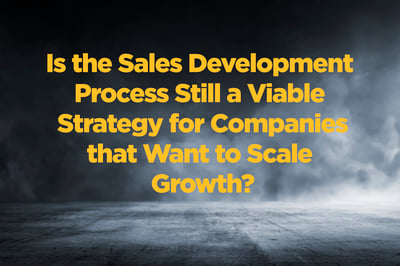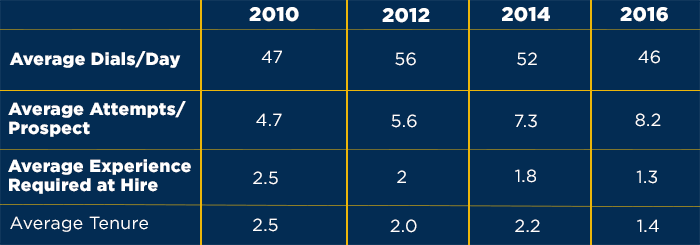 Over the last decade, the hottest trend for fast-growth sales organizations is the birth and dominant role of sales development teams to accelerate lead generation and the creation of qualified opportunities. Even as recently as five-years ago, sales development was still being adopted by only the most forward-leaning companies. Today, sales development is de rigueur. If you're a company that's committed to serious growth, a sales development function is pretty much table stakes.
Over the last decade, the hottest trend for fast-growth sales organizations is the birth and dominant role of sales development teams to accelerate lead generation and the creation of qualified opportunities. Even as recently as five-years ago, sales development was still being adopted by only the most forward-leaning companies. Today, sales development is de rigueur. If you're a company that's committed to serious growth, a sales development function is pretty much table stakes.
In our own way, we've contributed to this reality. In 2015, I spoke at Inbound sharing how sales development was not only a complement to Inbound Marketing, it was necessary to successful execution. Back then (if two and a half years ago can be considered "back then") my topic was controversial with many people arguing against it. Today if I were to present such a topic I'd be lucky if anyone other than a member of my team was present for the session.
I talk with executives every day about growth. I see how the strategy how gets implemented today. While there is a tremendous amount of content available on sales development (with more coming every day), one question doesn't seem to be asked: is it still a viable strategy?
A Brief History of The Sales Development Function
Sales development is both old and new. For those not familiar with the function, sales development separates the high volume prospecting and outreach associated with sales and assigns it to a specialized, dedicated team. The sales development teams' job is to make cold calls as well as to respond to inbound leads. Most sales development organizations have moved beyond pure cold calling to integrate emails and social interactions as well. Those actions, combined with the ability to collect and analyze terabits of data brought a professionalization and discipline to the "cold call cowboy."
Sales development started to hit the mainstream when Aaron Ross and Marylou Tyler released the book Predictable Revenue: Turn Your Business Into A Sales Machine with the $100 Million Best Practices of Salesforce.com. In the book, Ross shared how he used sales development to grow Salesforce.com's SMB business to more than $100 million. From there, a new industry was born. Thought leaders and practitioners like Trish Bertuzzi and John Barrows, combined with sales tech startups like Kyle Porter's SalesLoft brought increased attention and insights to bear.
Every Great Cause Starts as a Movement, Becomes a Business and Eventually Degenerates Into a Racket
You have almost assuredly been exposed to the sales development function. I just checked my inbox and there are currently seven different crappy emails sent from different companies implementing a sales development process. You know the emails, they look something like this:
Hi Doug,
Let's talk for 15 minutes on Tuesday at 2 pm or 4 pm. Our crappy company does something that you're not looking for, but hey it's probably worth it that we talk. Just click here and I can take away 15 minutes (or more) from your life that you'll never have back.
Let's talk,
SDR
Okay, the emails aren't that bad (although on second thought, some of them are). It would be easy to blame salespeople or sales executives for the sad state of affairs we find ourselves in, it's not like salespeople are the only people to fuck up a good thing. The CMO of the inventor of inbound marketing recently wrote a post where he shared that "marketers fuck everything up."
Don't take my word for it, let's see what other people (on the buy side) are saying about the state of sales development today. The following comments from a brief review of my LinkedIn timeline:
- Cold calling is dead.
- Why do we keep selling in a way that we don't buy?
- If another person fills my inbox with another one of these emails I may lose it.
- Dear SDR, if I didn't answer your email the first 7 times you sent it, the reason I'm not responding is that I COULDN'T CARE LESS ABOUT YOU, YOUR PRODUCT OR YOUR COMPANY, not because a file cabinet fell on me.
Sure, Doug, you may be thinking, it's easy to find somebody saying something bad about anything. Besides, I thought you were a data guy. Who cares about stories, what's the data say? The Bridge Group does as good a job as anyone in monitoring the pulse of the sales development world. They're constantly researching and surveying to stay on top of trends and to benchmark. Here's some data from their most recent report on sales development:

This is the state of sales development in 2018:
- There's a downward trend on contacts made per day (despite greater investments in sales technology).
- It takes 75% more attempts to connect with a lead than it did just over 5 years ago.
- Companies are hiring reps with almost half the experience than they did previously.
- SDR tenure (that was never great, to begin with) is down 40%. Plus, when you consider it typically takes 3 - 6 months to ramp up an SDR it means that an SDR is "productive" for less than a year on average.
There's no other way to describe this data other than it's bad. Despite this data, there is more pressure than ever for companies to increase their growth rates and their response to these trends is to hire more SDRs, (who have even less experience) to send out more crappy emails, make more crappy calls and leave more crappy voicemails. The mentality is that if the yields from sales development are decreasing, the way to make it up is with volume. Companies are destroying their addressable markets in pursuit of short-term growth--and it's not working!
From this angle, the answer is clear: Sales development is dying and companies are simply trying to get the last bits of life from the pursuit.
But, I think the question I posed at the beginning of this post is the wrong question. Let me change it from "is sales development still a viable strategy?" The operative question should be:
Are the problems and degradation we're seeing in sales development resulting from a lack of viability or because of bad strategy and execution?
It is here where I have good news.
The 4 Archetypes of Sales Development
The good news is that there's nothing actually wrong with the sales development strategy. It's as viable today as it was when it became popular. The problem is that, virtually across the board, only one approach is employed, with little to no thought given to the problem that the business is looking to solve and the effectiveness of the approach being taken.
I've spent the last five years not only executing sales development efforts but studying hundreds more. I get to work in a fun little laboratory where I can test a variety of different approaches and different situations. Additionally, because Imagine works with companies on demand generation and lead generation, as well as new sales, I'm arms-deep in the issues around alignment and reality every day. While I could make this as complicated as you'd like, I've identified four distinctly different sales development approaches or archetypes.
Each of these approaches represents a different type of sales development - a different game if you will - that requires a different playbook, with different processes, metrics, content and implementation. When you apply the wrong approach to a situation you get chaos, complexity and confusion.

High-Velocity Sales Development: This is the dominant playbook. It's what Aaron Ross did at Salesforce.com, and it's what's causing the exponential growth of bad emails and calls. It would be easy to write off sales development because of how this approach is implemented today. Before throwing the baby out with the bathwater, consider the situation Ross exploited.
When Ross implemented his playbook, the CRM category was well established and Salesforce.com had established itself as a leading player in the enterprise market. It also happened that the dominant emerging trend was moving to the cloud. Therefore, there was a strong level of established demand in a defined product category that prospects quickly understood. Additionally, Salesforce.com represented a superior platform for less money than it would cost in the initially for SMB's to purchase a legacy product.
This is the precise type of market the High-Velocity Sales Development work best in:
- A highly defined market
- A highly defined and understood product category
- Strong existing demand in the market
- Moderate to low sales price (or ACV)
Target & Cultivate: If you're reading this post and you remember the days before sales development was a hot topic, you may remember the discipline that was often referred to as inside sales. The Target & Cultivate approach will remind you of those days. In this approach, an SDR works a defined universe of leads over an extended period-of-time. The SDR is responsible for building the business case, establishing communication with multiple role players and yes, nurturing quality leads, so that when the opportunity for action emerges the SDR can move them further through the buying journey.
Strategic Prospecting: This requires a bit more talent, experience and/or teamwork. Strategic Prospecting is akin to developing the old "target list." Reps (new sales reps and SDRs) are responsible for selecting a list of prospect accounts. To penetrate the account, individual attention needs to be paid to each account, multiple points of entry need to be identified and customized messaging and outreach needs to be implemented. If this is beginning to sound like Account-Based Marketing (ABM) there's a good reason; I often refer to this approach as ABM light.
Full-Scale ABM: Is a highly strategic, fully integrated approach, and the subject of another blog post. If you'd like a primer on ABM, we've shared these thoughts before.
To determine which sales development approach should be taken, you must consider:
- The product you're selling
- Where in the business life cycle your company and your offering are
- How defined your product/service category is
- The level of demand that currently exists for product/service
- The complexity involved in the buying process
- The sophistication of your ideal client profile and personas
- Your target ACV
By the way, it is not unusual for multiple playbooks to be needed to address your markets effectively.
5 Keys to Successfully Implementing Sales Development at Your Company
- Determine the appropriate approach(es) for your market(s).
- Build your playbook (don't steal it, your playbook needs to be built for you).
- Align your sales development process with the entire customer acquisition process.
- Allocate the necessary resources--time, money, intelligence, content, etc.--to be successful. Don't expect that volume of activity will make up for a lack of quality.
- Track everything you do, measure appropriate, learn constantly and adjust consistently.
The bottom line is that sales development is not only still a viable strategy, it's a competitive advantage when it's designed and implemented with purpose, rigor and discipline. It's an albatross when it's not. You may move the needle in the short-term, but your costs are going to explode, your growth rate is going to stall and you'll burn your addressable market.

 Doug Davidoff
Doug Davidoff
